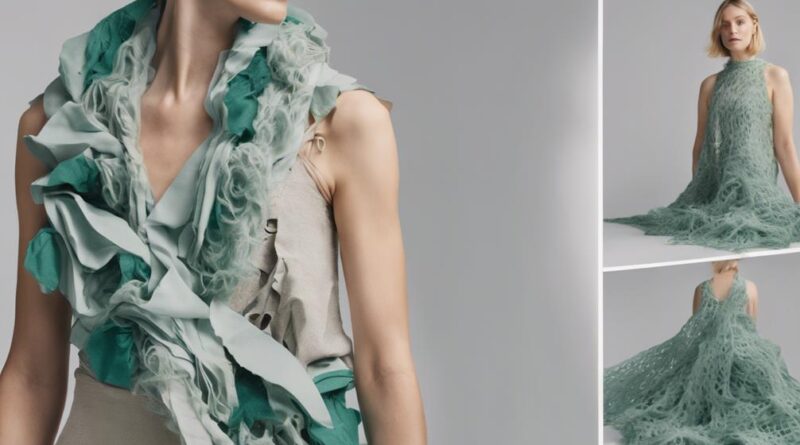Exploring the Advantages of a Circular Fashion Economy
In a circular fashion economy, garments are designed to be fully recyclable, such as Adidas' collaboration with Parley for the Oceans turning ocean plastic into shoes. By embracing this model, you can witness a shift towards sustainable practices that not only benefit the environment but also offer various advantages to the fashion industry as a whole.
Imagine the possibilities of reducing waste, minimizing environmental impact, and fostering a culture of innovation. The circular fashion economy holds promise for transforming the way we view and interact with clothing, presenting a path towards a more sustainable future.
Reducing Fashion Industry Waste
To minimize the environmental impact of the fashion industry, embracing circular practices is crucial in reducing fashion industry waste. By shifting towards sustainable materials and enhancing production efficiency, significant progress can be made in decreasing the amount of waste generated by the fashion industry.
When opting for sustainable materials in fashion production, such as organic cotton, recycled polyester, or Tencel, you're choosing materials that have a lower environmental footprint compared to traditional ones. These materials are often biodegradable, renewable, or require less water and energy to produce, contributing to a more sustainable fashion ecosystem. By incorporating these materials into your designs, you actively reduce the environmental strain caused by the fashion industry.
Moreover, improving production efficiency plays a vital role in waste reduction. By streamlining processes, optimizing supply chains, and reducing overproduction, you can minimize the amount of excess inventory and unsold garments that end up in landfills. Adopting lean manufacturing principles and embracing technology can help in producing only what's needed, reducing waste along the entire fashion production chain.
Extending Product Lifecycles
Extending the lifespan of your clothing items through proper care and maintenance significantly contributes to a more sustainable fashion cycle. By taking steps to prolong the life of your garments, you actively participate in reducing waste and environmental impact within the fashion industry.
Here are some ways you can extend the lifecycle of your clothing:
- Repair Initiatives: Instead of discarding a piece of clothing at the first sign of damage, consider repairing it. Sewing on a missing button, patching up a small hole, or fixing a broken zipper can breathe new life into your garment and prevent it from ending up in a landfill prematurely.
- Upcycling Projects: Get creative and transform old or unworn clothing items into something new and exciting through upcycling. Whether it's turning a pair of jeans into shorts, repurposing a t-shirt into a tote bag, or combining different pieces to create a unique outfit, upcycling allows you to give your clothes a second chance at being useful and stylish.
- Proper Care and Maintenance: Simple actions like following care instructions on garment labels, washing clothes at the right temperature, and storing them properly can significantly extend their lifespan. By taking good care of your clothing, you can enjoy them for longer periods and reduce the frequency at which you need to replace them.
Minimizing Environmental Impact
By adopting sustainable practices in your wardrobe, you can actively reduce the environmental impact of the fashion industry. One way to do this is by choosing eco-friendly materials. Eco-friendly materials are those that have been sourced and produced in a way that minimizes harm to the environment. These can include organic cotton, hemp, bamboo, and recycled polyester. By opting for clothing made from these materials, you're supporting the use of resources that are replenishable and have a lower carbon footprint.
In addition to selecting eco-friendly materials, you can also look for products that have been created using sustainable production techniques. Sustainable production techniques focus on minimizing waste, reducing energy consumption, and decreasing the use of harmful chemicals. This can involve practices such as water recycling, using renewable energy sources, and implementing ethical labor standards. By supporting brands that prioritize sustainable production techniques, you're encouraging a shift towards more environmentally friendly practices within the fashion industry.
Encouraging Sustainable Consumption
Encouraging mindful consumption practices can significantly contribute to the sustainability of the fashion industry. By being more conscious of your purchasing decisions and opting for ethically produced clothing, you can help drive positive change within the fashion sector.
Benefits of Mindful Consumption:
- Reduced Environmental Impact: Mindful purchasing involves choosing items that are made with sustainable materials and production processes. By supporting brands that prioritize ethical production, you're promoting a more environmentally friendly fashion industry.
- Supporting Fair Labor Practices: When you opt for ethically produced garments, you're supporting fair labor practices in the fashion supply chain. This helps ensure that the workers involved in the production of clothing are treated fairly and ethically.
- Promoting Longevity in Fashion: Mindful consumption encourages you to invest in high-quality pieces that are designed to last. By choosing durable items over fast fashion trends, you're promoting a more sustainable approach to fashion consumption.
Fostering Innovation in Design
To foster innovation in design within the circular fashion economy, consider exploring new materials and production techniques that prioritize sustainability and creativity. Sustainable materials play a crucial role in reshaping the fashion industry. By utilizing materials like organic cotton, hemp, or recycled fabrics, designers can reduce the environmental impact of their creations. These materials not only minimize waste but also contribute to a more sustainable production cycle.
Incorporating sustainable materials into your designs can inspire creative processes that lead to unique and innovative fashion pieces. Think beyond traditional fabrics and explore unconventional materials like pineapple leather, mushroom leather, or recycled plastic textiles. Embracing these alternatives not only challenges the norms of traditional fashion but also opens up a world of possibilities for creating eco-conscious and distinctive designs.
Furthermore, creative processes in design can be enhanced by experimenting with innovative production techniques. Consider techniques like 3D printing, zero-waste pattern cutting, or upcycling to breathe new life into old garments. These methods not only add a touch of originality to your designs but also contribute to reducing waste and promoting sustainability in the fashion industry.
Creating Economic Opportunities
Explore how incorporating sustainable materials and innovative production techniques in design can't only foster creativity but also generate new economic opportunities within the circular fashion economy. By embracing these practices, you can contribute to job creation and community development, making a positive impact beyond just the environmental aspect.
- Job Creation:
Utilizing sustainable materials and techniques requires skilled labor, leading to the creation of new job opportunities in fields such as eco-friendly material sourcing, ethical production, and circular fashion design.
- Community Development:
By integrating circular principles into the fashion industry, you can help build stronger and more resilient communities. This can be achieved through supporting local artisans, promoting fair wages, and establishing partnerships with community organizations.
- Economic Growth:
Investing in sustainable practices not only benefits the environment but also stimulates economic growth. By pioneering circular fashion initiatives, you can attract new investors, drive innovation, and contribute to the overall prosperity of the industry.
Through your commitment to sustainability and innovation in design, you have the power to not only shape the future of fashion but also create meaningful economic opportunities for individuals and communities alike.
Enhancing Brand Reputation

Improving your brand's reputation in the circular fashion economy involves strategically aligning your values with sustainable practices and transparent communication. By emphasizing sustainability in your operations, you can build brand loyalty and enhance customer trust. Consumers are increasingly seeking environmentally conscious brands that prioritize ethical production processes and reduce waste. By showcasing your commitment to sustainability through actions like using recycled materials, implementing take-back programs, and promoting fair labor practices, you can attract eco-conscious consumers who value transparency and ethical standards.
Communicating your sustainability efforts effectively is key to strengthening your brand reputation. Utilize your marketing channels to share your sustainability initiatives, from social media campaigns to labeling your products with information about their eco-friendly attributes. Transparent communication about your supply chain and manufacturing processes helps build trust with consumers who are seeking authenticity and accountability from the brands they support.
In the circular fashion economy, a strong brand reputation is pivotal for long-term success. Customers who trust your brand's commitment to sustainability are more likely to become loyal supporters, advocating for your products and contributing to a positive brand image. By aligning your values with sustainable practices and fostering transparent communication, you can enhance your brand reputation, attract environmentally conscious consumers, and ultimately drive growth in the circular fashion economy.
Building a Resilient Industry
Enhancing your brand's reputation through sustainable practices sets a strong foundation for building a resilient industry in the circular fashion economy. By implementing resilient strategies and fostering industry collaboration, you can ensure the long-term success and sustainability of your brand within the ever-evolving landscape of fashion.
- Investing in Innovation: Embracing innovative technologies and materials can help your brand stay ahead of the curve. By continuously seeking new ways to reduce waste and improve production processes, you can create a more resilient business model that adapts to changing consumer demands and environmental challenges.
- Embracing Transparency: Building trust with consumers and stakeholders through transparent practices is key to weathering industry challenges. By openly sharing information about your supply chain, sourcing practices, and environmental impact, you can demonstrate your commitment to sustainability and accountability, which in turn enhances your brand's resilience in the market.
- Fostering Industry Collaboration: Collaborating with other brands, suppliers, and organizations within the fashion industry can lead to shared knowledge, resources, and opportunities for growth. By working together towards common sustainability goals, you can strengthen the industry as a whole and create a more resilient ecosystem that supports positive change.
Frequently Asked Questions
How Can Consumers Actively Participate in Promoting a Circular Fashion Economy?
To promote a circular fashion economy, consumers engage by embracing sustainable practices.
You can start by buying clothes from eco-friendly brands, donating or upcycling old garments, and advocating for transparency in the fashion industry.
By making conscious choices and supporting ethical fashion, you actively participate in driving the shift towards a more sustainable and circular economy within the fashion sector.
Your actions have the power to make a significant impact on the industry's future.
What Role Do Governments and Policymakers Play in Supporting the Transition to a Circular Fashion Economy?
Governments and policymakers play a crucial role in supporting the transition to a circular fashion economy. They can introduce policies that encourage sustainable practices, provide funding for research and development of eco-friendly materials, and enforce regulations to reduce waste and pollution in the fashion industry.
Are There Specific Challenges or Barriers That the Fashion Industry Faces in Adopting Circular Practices?
In transitioning to a circular fashion economy, challenges and barriers exist. These hurdles can include shifting traditional linear production models, navigating complex supply chains, and changing consumer mindsets.
Embracing sustainable practices, enhancing recycling infrastructure, and promoting innovation are vital steps to overcome these obstacles.
How Do Supply Chain Transparency and Traceability Contribute to a More Sustainable Fashion Industry?
When it comes to sustainable fashion, supply chain transparency and traceability play crucial roles. By knowing exactly where materials come from and how they're produced, you can ensure sustainable sourcing practices.
This transparency leads to supply chain efficiency, reducing waste and environmental impact.
Ultimately, by tracking each step in the supply chain, you contribute to a more sustainable fashion industry.
What Are Some Examples of Successful Collaborations Between Fashion Brands, Technology Companies, and Other Stakeholders in Advancing Circularity in the Industry?
To advance circularity in the fashion industry, successful collaborations between fashion brands, technology companies, and other stakeholders are crucial. Fashion tech partnerships drive innovation, while circular design initiatives aim to reduce waste and promote sustainability.
Conclusion
By embracing a circular fashion economy, you can contribute to reducing waste, extending product lifecycles, minimizing environmental impact, and fostering sustainable consumption.
This shift not only promotes innovation in design but also creates economic opportunities and enhances brand reputation.
Together, we can build a resilient and sustainable fashion industry for a better future. Make the choice to support circular fashion today.
